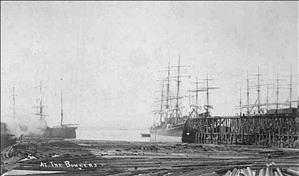The waterfront between Battery and Broad streets, beginning with Pier 69, is graced by the Edgewater Hotel, the Port of Seattle terminal for high-speed Victoria Clipper catamaran ferries, and Myrtle Edwards Park, which runs along Elliott Bay to Smith Cove. This northernmost part of the downtown waterfront has hosted a variety of historical uses including a yacht club, coal bunkers, canneries, barrel factory, grain and fishing piers, and an oil depot.
Depredations, Regradations, Renovations
The area was devastated by fire in 1910. Twenty years later, conveyors dumped dirt from the second Denny Regrade at the foot of Battery Street, creating a shifting submarine mountain so large it had to be dredged to protect navigation.
The Edgewater Hotel has occupied Pier 67 since 1962. Early in 1962, the 530-foot-long Galbraith Bacon dock and its neighbor to the north, the 200-foot Booth Fisheries pier, were cleared for the construction of the inn, which opened in the spirit of, if not in time for, the opening of Seattle’s Century 21 World's Fair. The modern romance suggested in the architect’s renderings were made more prosaic when the outer wall that faced north was left featureless except for a sign that promised visitors that they could fish from their window. The hotel’s other well-known trivia was the visit of the Beatles, who were reported to have indeed fished from their windows.
Pier 69 and Pier 70
The former Pier 69 was built by the Roslyn Coal and Coke Company in 1900. The American Can Company took over the site in the 1920s, and built the upland factory (which now houses high-tech and dot-com enterprises). In 1993, the Port of Seattle redeveloped Pier 69 as its headquarters and new terminal for high-speed Victoria Clipper catamaran ferries.
Pier 70 was built in 1902 by Elton Ainsworth and Arthur G. Dunn Sr., businessmen who were involved in the fishing and shipping industries. One of the largest docks on the waterfront, Pier 70 later served as the terminal for the Blue Funnel and Hamburg-American shipping lines. In 1916, a spectacular fire destroyed the upper pier and roof. The Ainsworth & Dunn company quickly rebuilt the dock.
During World War II, the Washington State Liquor Board used the pier as a warehouse, and from 1946 to 1955, the pier served as the Seattle base for the U.S. Coast Guard. In 1970, inspired by the metamorphosis of the Ghirardelli Factory and Fisherman's Wharf in San Francisco, Ainsworth & Dunn converted the pier for retail and restaurant use. Triad Development bought the building in 1995 and renovated it into its current use as business space.
A finger pier north of Pier 70 once handled oil shipments to and from an adjacent Unocal tank farm. This pier was demolished for Myrtle Edwards Park (named for the late Seattle City Council member) in the early 1970s, and the northern terminus of the Waterfront Streetcar was added in 1982 (and later removed). The former oil depot was redeveloped as the Seattle Art Museum's new downtown sculpture garden, which opened in January 2007.

